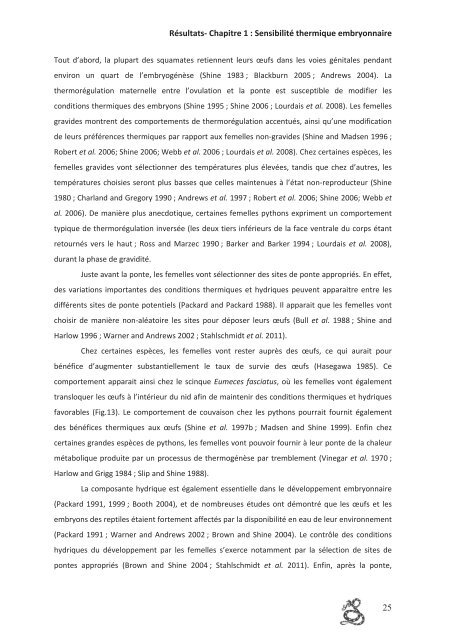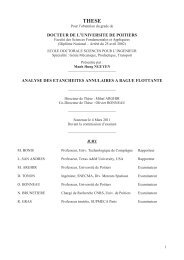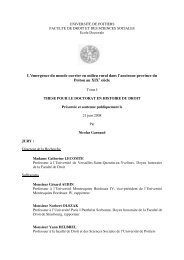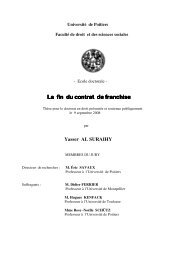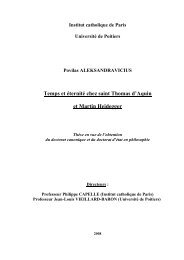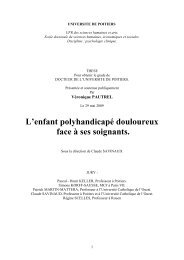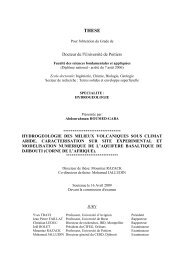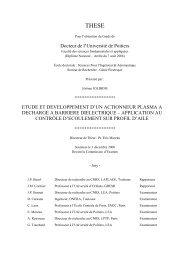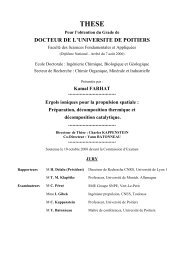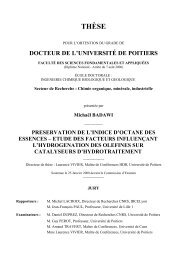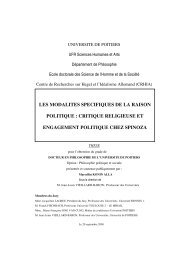Consulter le texte intégral de la thèse - Université de Poitiers
Consulter le texte intégral de la thèse - Université de Poitiers
Consulter le texte intégral de la thèse - Université de Poitiers
Create successful ePaper yourself
Turn your PDF publications into a flip-book with our unique Google optimized e-Paper software.
RésultatsChapitre1:Sensibilitéthermiqueembryonnaire<br />
Tout d’abord, <strong>la</strong> plupart <strong>de</strong>s squamates retiennent <strong>le</strong>urs œufs dans <strong>le</strong>s voies génita<strong>le</strong>s pendant<br />
environ un quart <strong>de</strong> l’embryogénèse (Shine 1983; B<strong>la</strong>ckburn 2005; Andrews 2004). La<br />
thermorégu<strong>la</strong>tion maternel<strong>le</strong> entre l’ovu<strong>la</strong>tion et <strong>la</strong> ponte est susceptib<strong>le</strong> <strong>de</strong> modifier <strong>le</strong>s<br />
conditionsthermiques<strong>de</strong>sembryons(Shine1995;Shine2006;Lourdaisetal.2008).Lesfemel<strong>le</strong>s<br />
gravi<strong>de</strong>smontrent<strong>de</strong>scomportements<strong>de</strong>thermorégu<strong>la</strong>tionaccentués,ainsiqu’unemodification<br />
<strong>de</strong><strong>le</strong>urspréférencesthermiquesparrapportauxfemel<strong>le</strong>snongravi<strong>de</strong>s(ShineandMadsen1996;<br />
Robertetal.2006;Shine2006;Webbetal.2006;Lourdaisetal.2008).Chezcertainesespèces,<strong>le</strong>s<br />
femel<strong>le</strong>sgravi<strong>de</strong>svontsé<strong>le</strong>ctionner<strong>de</strong>stempératuresplusé<strong>le</strong>vées,tandisquechezd’autres,<strong>le</strong>s<br />
températureschoisiesserontplusbassesquecel<strong>le</strong>smaintenuesàl’étatnonreproducteur(Shine<br />
1980;Char<strong>la</strong>ndandGregory1990;Andrewsetal.1997;Robertetal.2006;Shine2006;Webbet<br />
al.2006).Demanièreplusanecdotique,certainesfemel<strong>le</strong>spythonsexprimentuncomportement<br />
typique<strong>de</strong>thermorégu<strong>la</strong>tioninversée(<strong>le</strong>s<strong>de</strong>uxtiersinférieurs<strong>de</strong><strong>la</strong>faceventra<strong>le</strong>ducorpsétant<br />
retournés vers <strong>le</strong> haut; Ross and Marzec 1990; Barker and Barker 1994; Lourdais et al. 2008),<br />
durant<strong>la</strong>phase<strong>de</strong>gravidité.<br />
Justeavant<strong>la</strong>ponte,<strong>le</strong>sfemel<strong>le</strong>svontsé<strong>le</strong>ctionner<strong>de</strong>ssites<strong>de</strong>ponteappropriés.Eneffet,<br />
<strong>de</strong>svariationsimportantes<strong>de</strong>s conditionsthermiquesethydriquespeuventapparaitreentre<strong>le</strong>s<br />
différentssites<strong>de</strong>pontepotentiels(PackardandPackard1988).I<strong>la</strong>pparaitque<strong>le</strong>sfemel<strong>le</strong>svont<br />
choisir <strong>de</strong> manière nonaléatoire <strong>le</strong>s sites pour déposer <strong>le</strong>urs œufs (Bull et al. 1988; Shine and<br />
Harlow1996;WarnerandAndrews2002;Stahlschmidtetal.2011).<br />
Chez certaines espèces, <strong>le</strong>s femel<strong>le</strong>s vont rester auprès <strong>de</strong>s œufs, ce qui aurait pour<br />
bénéfice d’augmenter substantiel<strong>le</strong>ment <strong>le</strong> taux <strong>de</strong> survie <strong>de</strong>s œufs (Hasegawa 1985). Ce<br />
comportementapparaitainsichez<strong>le</strong>scinqueEumecesfasciatus,où<strong>le</strong>sfemel<strong>le</strong>svontéga<strong>le</strong>ment<br />
transloquer<strong>le</strong>sœufsàl’intérieurdunidafin<strong>de</strong>maintenir<strong>de</strong>sconditionsthermiquesethydriques<br />
favorab<strong>le</strong>s (Fig.13). Le comportement <strong>de</strong> couvaison chez <strong>le</strong>s pythons pourrait fournit éga<strong>le</strong>ment<br />
<strong>de</strong>s bénéfices thermiques aux œufs (Shine et al. 1997b; Madsen and Shine 1999). Enfin chez<br />
certainesgran<strong>de</strong>sespèces<strong>de</strong>pythons,<strong>le</strong>sfemel<strong>le</strong>svontpouvoirfournirà<strong>le</strong>urponte<strong>de</strong><strong>la</strong>cha<strong>le</strong>ur<br />
métaboliqueproduiteparunprocessus<strong>de</strong>thermogénèsepartremb<strong>le</strong>ment(Vinegaretal.1970;<br />
HarlowandGrigg1984;SlipandShine1988).<br />
Lacomposantehydriqueestéga<strong>le</strong>mentessentiel<strong>le</strong>dans<strong>le</strong>développementembryonnaire<br />
(Packard1991,1999;Booth2004),et<strong>de</strong>nombreusesétu<strong>de</strong>sontdémontréque<strong>le</strong>sœufset<strong>le</strong>s<br />
embryons<strong>de</strong>srepti<strong>le</strong>sétaientfortementaffectéspar<strong>la</strong>disponibilitéeneau<strong>de</strong><strong>le</strong>urenvironnement<br />
(Packard1991;Warnerand Andrews2002;BrownandShine 2004). Le contrô<strong>le</strong> <strong>de</strong>s conditions<br />
hydriques du développement par <strong>le</strong>s femel<strong>le</strong>s s’exerce notamment par <strong>la</strong> sé<strong>le</strong>ction <strong>de</strong> sites <strong>de</strong><br />
pontes appropriés (Brown and Shine 2004; Stahlschmidt et al. 2011). Enfin, après <strong>la</strong> ponte,<br />
25


